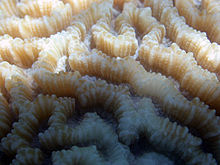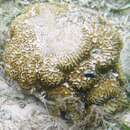Biology
provided by Arkive
Platygyra daedalea is a hermatypic coral which has microscopic algae known as zooxanthellae living within its tissues. These produce energy-rich molecules through photosynthesis, transferring most of what is produced to the coral, and in return receiving protection from currents, access to sunlight, and some nutrients from the coral's waste products. Since the zooxanthellae need sunlight for photosynthesis, corals such as Platygyra daedalea are restricted to clear, shallow, warm waters (3) (10).
Coral colonies grow through a form of asexual reproduction known as budding, in which polyps divide themselves to form new polyps (3). Corals can also reproduce sexually by spawning, which in Platygyra daedalea involves the release of gametes into the water, for external fertilisation. Platygyra daedalea is hermaphroditic, meaning that each polyp produces both eggs and sperm. Spawning in this species usually occurs once a year, sometimes twice, and in some areas may be timed to coincide with the monsoon, when sea surface temperatures are highest and wind conditions are slow and steady (11) (12).
Platygyra daedalea is thought to be a relatively 'aggressive' coral, producing elongated tentacles, known as 'sweeper tentacles', which can damage the tissues of neighbouring corals, helping Platygyra daedalea to compete for space on the reef (7).
Conservation
provided by Arkive
Platygyra daedalea is listed on Appendix II of the Convention on International Trade in Endangered Species (CITES), meaning that international trade in this species should be carefully regulated (2). Parts of its range occurs within Marine Protected Areas (1), which are set aside from unrestricted human activities and may include, for example, 'no-take' zones, where removal of marine life is prohibited. However, only an estimated one percent of the world's oceans currently receive protection, and enforcement in these protected areas is often poor (10).
Conservation measures recommended for Platygyra daedalea include the establishment and management of new protected areas, the expansion of existing protected areas, and the management of diseases and parasites. In particular, further research is needed into the species' abundance and population trends, its ecology, its resilience to various threats, and the potential impacts of collection for the aquarium trade. Suitable management measures, such as quotas and size limits for harvesting, are also required. In the future, techniques for artificially growing corals and for preserving their gametes may become important in the conservation of coral biodiversity (1), and ongoing reef monitoring and increased awareness will also be important tools in efforts to protect these fragile marine ecosystems (10).
Description
provided by Arkive
This coral gains its common name from the colony's meandering, brain-like pattern of brown walls, separated by grey or green depressions known as 'valleys' (3) (4). Platygyra daedalea colonies are large, up to a metre or more in diameter (1) (4), and are typically mound-shaped or plate-like (encrusting) (3). However, there is wide variation in colony shape and form, which, intriguingly, appears unrelated to the species' environment or genetic makeup (5) (6). Coral colonies are composed of polyps, tiny, anemone-like animals which secrete the coral skeleton. However, unlike in many other corals, the polyps of Platygyra daedalea colonies are not individually identifiable. Instead, all polyps within the colony share common walls, with the polyp 'mouths' aligned in valleys, which in this species typically measure up to 30 millimetres long and 6 millimetres wide (3) (4). The tentacles of the polyps are usually only extended at night (3).
Platygyra daedalea can be difficult to distinguish from the less common Platygyra lamellina, the two species sometimes being classed together in the past (6). However, it can be distinguished by its thicker, more flat-topped and straight-sided walls, and by having valleys that are wider than the separating walls. Platygyra daedalea also has characteristically ragged septa, the radial elements that project inwards from the skeletal wall of each polyp (3) (7) (8).
Habitat
provided by Arkive
Common over a variety of reef habitats, particularly back reef margins, Platygyra daedalea can be found at depths of up to 30 metres (1) (3) (9).
Range
provided by Arkive
Platygyra daedalea is widely distributed throughout the Indian and Pacific Oceans, including in the Red Sea and Gulf of Aden, the Arabian / Iranian Gulf, and around Australia and Southeast Asia (1) (4) (9).
Status
provided by Arkive
Classified as Least Concern (LC) on the IUCN Red List (1) and listed on Appendix II of CITES (2).
Threats
provided by Arkive
Although widespread and common (1) (3), and believed to be relatively resilient to habitat loss and reef degradation (1), Platygyra daedalea faces a number of threats that are impacting coral reefs around the world, and so is assumed to be undergoing a population decline (1). An estimated 20 percent of the world's coral reefs have already been destroyed, and a large percentage of those remaining are at risk of collapse as a result of human activities. These include overfishing, destructive fishing practices, coral mining, pollution, irresponsible tourism, and poor land management practices, which increase the amount of sediment, nutrients and pollutants entering the ocean (1) (10). In general, however, climate change may pose the greatest risk to corals, raising the risk of temperature extremes which can stress coral and cause it to lose its zooxanthellae. This process, known as 'bleaching', usually results in the death of the coral. Climate change may also lead to more severe, frequent storms, which can damage reefs, and rising carbon dioxide levels may lead to ocean acidification, which can reduce coral's ability to create its hard skeleton (1) (10). Such stresses may also make corals more susceptible to disease (1). In addition to these general threats, Platygyra daedalea is also the target of collection for the aquarium trade (1).
Platygyra daedalea
provided by wikipedia EN
Platygyra daedalea, sometimes known as the lesser valley coral, is a colonial species of stony coral in the family Merulinidae. It occurs on reefs in shallow water in the Indo-Pacific region. It is a common species and the International Union for Conservation of Nature has assessed its conservation status as being of "least concern".[1]
Description
Platygyra daedalea usually forms massive dome or boulder-shaped colonies which may be a metre (yard) or more in diameter; however, sometimes it forms flattened plates or it may be encrusting. The polyps are situated in meandering valleys with low walls between them which are often perforated. The septa are toothed and protuberant, usually with uneven or pointed tips. There is an obvious ridge, the columella, in the centre of the valley. The colour varies and there may be contrasting valleys and ridges. This coral can be distinguished from the similar but less common Platygyra lamellina by the fact that the valleys are wider and the walls between them have more vertical sides and have flatter tops.[3][4]
Distribution and habitat
Platygyra daedalea is a common species with a widespread distribution in the Indo-Pacific region. Its range extends from Madagascar, the east coast of Africa, the Red Sea and the Gulf of Aden, to Australia, Indonesia, Japan and the South China Sea. It is present in various reef environments, particularly on back reef slopes, from subtidal rocks down to about 30 metres (100 ft). It is particularly common in the Gulf of Thailand and South China Sea.[1]
Ecology

P. daedalea with polyps expanded
The polyps of P. daedalea expand at night to catch planktonic particles floating by. However, this coral obtains most of its nourishment from the dinoflagellates known as zooxanthellae it houses within its tissues. These provide organic carbon and nitrogen, the products of photosynthesis, to their host. To benefit from this symbiotic arrangement, P. daedalea needs to grow in shallow, sunlit environments.[4]
Platygyra daedalea is an aggressive coral and seeks to prevent competitors from overshadowing it. Researchers placed small colonies of this species alongside similar-sized colonies of the less-aggressive Favites complanata. Some of the tentacles of P. daedalea developed into sweeper tentacles which then inflicted damage on the soft tissues of the adjoining F. complanata. These sweeper tentacles were up to 90 millimetres (3.5 in) in length, about fifteen times as long as a normal tentacle, and well armed with cnidocytes. The soft tissue damage was extensive, the skeleton was laid bare in places and sponges, algae and other fouling organisms grew on it. Three of the ten corals that were attacked eventually died.[5]
References
-
^ a b c DeVantier, L.; Hodgson, G.; Huang, D.; Johan, O.; Licuanan, A.; Obura, D.O.; Sheppard, C.; Syahrir, M.; Turak, E. (2014). "Platygyra daedalea". IUCN Red List of Threatened Species. 2014: e.T133468A54267376. doi:10.2305/IUCN.UK.2014-1.RLTS.T133468A54267376.en. Retrieved 19 November 2021.
-
^ a b Hoeksema, Bert (2015). "Platygyra daedalea (Ellis & Solander, 1786)". WoRMS. World Register of Marine Species. Retrieved 2015-06-12.
-
^ Chang-feng Dai; Sharon Horng (2009). 台灣石珊瑚誌. 國立臺灣大學出版中心. p. 116. ISBN 978-986-01-8745-8.
-
^ a b "Brain coral (Platygyra daedalea)". ARKive. Archived from the original on 2015-07-04. Retrieved 2015-06-12.
-
^ Lapid, Einat D.; Chadwick, Nannette E. (2006). "Long-term effects of competition on coral growth and sweeper tentacle development" (PDF). Marine Ecology Progress Series. 313: 115–123. doi:10.3354/meps313115.

- license
- cc-by-sa-3.0
- copyright
- Wikipedia authors and editors
Platygyra daedalea: Brief Summary
provided by wikipedia EN
Platygyra daedalea, sometimes known as the lesser valley coral, is a colonial species of stony coral in the family Merulinidae. It occurs on reefs in shallow water in the Indo-Pacific region. It is a common species and the International Union for Conservation of Nature has assessed its conservation status as being of "least concern".
- license
- cc-by-sa-3.0
- copyright
- Wikipedia authors and editors
Biology
provided by World Register of Marine Species
zooxanthellate
van der Land, J. (ed). (2008). UNESCO-IOC Register of Marine Organisms (URMO).
- license
- cc-by-4.0
- copyright
- WoRMS Editorial Board
Description
provided by World Register of Marine Species
This is a fully meandroid species with valleys wider than the separating walls. The walls are sharply angular, and are usually perforated. Septa are exsert and pointed above the walls. They are in two orders, but are irregular rather than regularly alternating. The columella is a ragged, loose floor of spicules. Platygyra daedalea is a fairly common species in mid-depths on fore-reef slopes. It is the commonest species of this genus over all depths except on reef flats. (Sheppard, 1998 ) Colonies are massive to encrusting, meandroid or submeandroid, with thick walls. Septa are exsert and have a characteristically ragged appearance. Colour: usually brightly coloured, most commonly with brown walls and grey or green valleys. Abundance: common over a wide range of habitats, especially back reef margins. (Veron, 1986 ) Colonies are a striking sight, ranging from encrustations to domes or micro-atolls. The meandering, convoluted calices have high walls surrounding elongated valleys. The Pattern is reminiscent of the folds of a brain, giving this coral its common name. Colour: the walls are always a dark brownish-green and the valleys a bright green or, less commonly, grey. Habitat: diverse reef areas. (Richmond, 1997)
Roux, J.P. (2001) Conspectus of Southern African Pteridophyta. Southern African Botanical Diversity Network Report 13 Page 118 (Includes a picture).
- license
- cc-by-4.0
- copyright
- WoRMS Editorial Board

